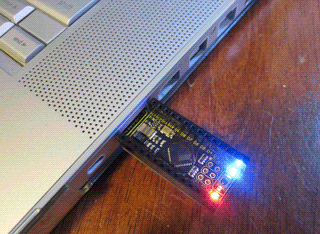The LeoStick is designed to be functionally similar to the Arduino Leonardo, but given the "honey, I shrunk the kids" treatment!
Just pop it into your USB port (no cable required!) and upload straight from the Arduino IDE. We've even included on-board RGB LED lights and a speaker in this handy sized board. All the usual Arduino pins are present and each LeoStick comes with low profile header sockets for plugging in modules, special tiny shields, and wires.
Features of the LeoStick include:
- Native USB port built-in, no need for any USB or FTDI cables
- Two Full Color RGB LEDs on-board! Drive different colored outputs and fun feedback from your sketch right away. One RGB LED is completely programmable, the other does Power, USB RX and TX indication, the RX and TX LEDs can also be controlled.
- On-board Piezo speaker element, play sounds, tunes and beeps. Can also be used as a knock/vibration sensor
- Same I/O pins. The LeoStick provides all the same header connections as larger boards, you can connect all the same sensors, actuators, and other inputs and outputs as typical Arduino models.
- Breadboard compatible, has 0.1" pitch pads and header pins can be fitted underneath
- 500mA polyfuse and protection on the USB port
- ATmega32U4 microcontroller, Arduino compatible with on-board USB, 32K Flash, 2.5K RAM, 1K EEPROM at 16MHz
- ISP 6-pin connector for advanced programming of the ATmega32U4 MCU
Getting to know your LeoStick
We have an active community forum here for fun LeoStick programs, installation and setup tips.
Our usual Getting Started guide page is here, including the first setup of the Arduino 1.0.x IDE for LeoStick support.
Please note: Although the LeoStick is Arduino Leonardo compatible it is not a Leonardo. Please don't hassle the Arduino team with support or requests related to this board: they're solely our responsibility.
The LeoStick is also a very complete ATmega32U4 breakout and USB board by itself and the LeoStick can be programmed directly from the supplied standard ISP header by AVR Studio, Mac OSX-AVR, avrdude, WinAVR etc.




















